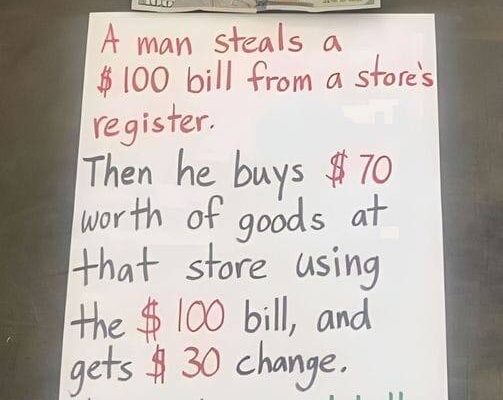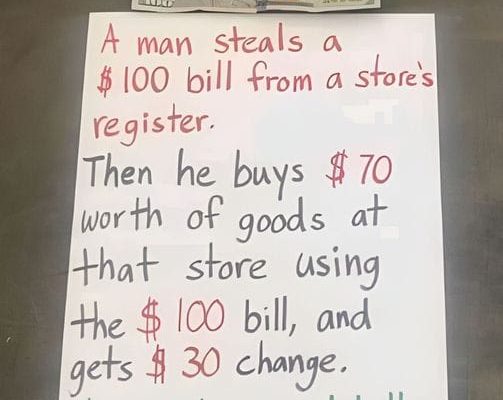In the age of viral content, a seemingly simple brain teaser about a store’s loss after a thief steals $100 has ignited debates across the internet. This puzzle, which first appeared on the social media platform X (formerly known as Twitter), asks participants to determine the total loss a store incurs when a thief steals $100 and then makes a purchase using that same stolen bill.
The scenario goes like this: A man steals a $100 bill from a store’s register. He then uses that stolen $100 bill to purchase $70 worth of goods, receiving $30 in change. The brain teaser poses a straightforward question: “How much money did the store lose?”
At first glance, the answer seems obvious to many. Some argue that the store only lost the initial $100 that was stolen. Others take it a step further, calculating that the store lost $130, accounting for both the stolen $100 and the $30 given in change. This divergence in answers has fueled an ongoing debate among puzzle enthusiasts.
But to truly crack this puzzle, it’s essential to break down the situation in detail. Let’s dissect the entire scenario:
-
- The Theft: Initially, the store loses $100 when the thief takes the bill from the register.
- The Purchase: The thief then spends this stolen $100 in the store. Since the $100 bill is now being used as payment, the store technically “recovers” the stolen money. But here’s where it gets tricky.
- The Change: The store provides $30 in change to the thief. This $30 is real money from the store’s till, leading to a direct cash loss.
- The Goods: The thief walks away with $70 worth of goods. These goods represent an additional loss to the store, assuming the store paid something for them (which they likely did).
To sum up the losses:
-
- The $100 initially stolen is technically returned to the store when the thief uses it to make a purchase.
- However, the store gives away $30 in real cash as change.
- Additionally, the store loses $70 worth of goods.
Therefore, the total loss to the store amounts to $100 ($30 in cash + $70 in goods).
This brain teaser underscores the importance of carefully analyzing every aspect of a problem before arriving at a solution. It’s not just about the immediate theft but also about understanding the broader implications of subsequent actions, like the purchase and the issuance of change.
The internet’s fascination with this puzzle reveals a lot about human nature. People love challenges that push them to think critically and question their initial assumptions. The simplicity of the question juxtaposed with the complexity of the correct answer makes this brain teaser a perfect example of how appearances can be deceiving.
Beyond the sheer enjoyment of solving such puzzles, there’s a broader lesson to be learned here: always consider all the variables in any given scenario. In the world of retail, for example, losses aren’t just about what’s stolen. They also involve what’s given away, what’s spent, and the value of goods or services involved.
In a real-world context, this puzzle can also be a reminder for business owners and managers to think critically about how they handle losses. It’s easy to focus solely on the most apparent aspects of a loss—like the stolen cash—but overlooking the other factors, such as the cost of goods and the impact of issuing change, can lead to an underestimation of the total financial impact.
The viral spread of this brain teaser across social media platforms is a testament to its universal appeal. It taps into a deep-seated human need to solve problems and engage in debates. Whether you’re a puzzle enthusiast or someone who just enjoys a good challenge, there’s something inherently satisfying about cracking a conundrum that has stumped others.
Moreover, the popularity of this brain teaser highlights the power of social media in amplifying content that engages and challenges users. In a world where digital content is consumed at an unprecedented rate, puzzles like this serve as a reminder that sometimes, the most engaging content is not flashy or complex but rather something that makes people pause, think, and even argue a little.
In conclusion, the $100 brain teaser is more than just a simple puzzle; it’s a reflection of the complexities of problem-solving and the importance of considering all aspects of a situation. So, the next time you encounter a tricky question, take a moment to analyze all the details—because the answer might be more nuanced than it first appears. And who knows? You might just be the one to solve the next viral puzzle that takes the internet by storm.

